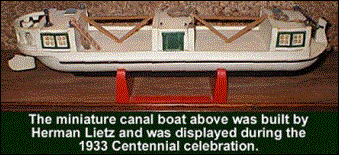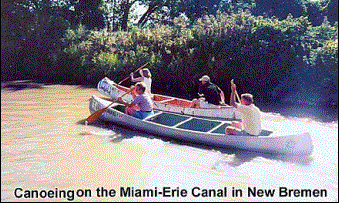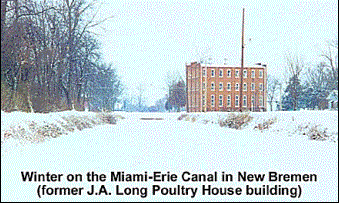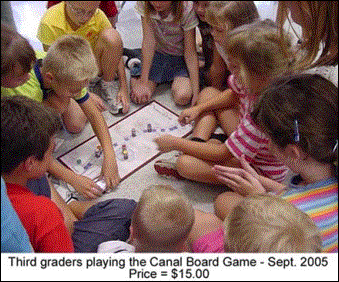No products
Fun on the Old Canal
by Ralph May
To those of us who spent our childhood in New Bremen during the days when the Miami & Erie was still filled with water and when a boat occasionally passed through, the “old waterway” and the “towpath” will ever be dear.
The canal not only divided the town in a sense of rivalry, but it was the center of all our boyish amusements. When the canal became a sheet of ice after Thanksgiving, the fun began.
The pond froze over first. We would then venture forth along the canal banks and try out the middle by throwing heavy stones upon the ice. If they rebounded across to the other side without going through at any point, we knew all was safe. We would then take our skates to Gast’s blacksmith shop to get them sharpened before putting them on.
We all learned to skate on Barney & Berry girls’ skates since these gave extra support at the heel and around the ankle. Also, they seldom came off. Boy’s skates were always coming loose.
We played ice polo on the pond starting early on Saturday mornings. Rabe’s Factory supplied the clubs and “the dumps” provided the tin cans. In those days, it was a long sweep from the base on the north end to the other base (“King’s pond”) on the south, and it took many a sturdy stride to carry the battered tin can along from one base to the other. If the can hit you on the shin, it usually laid you out for the rest of the day. Other games we played on the ice were “Fox & Geese” and “What are you doing in my vineyard?”
None of us will ever forget the Taylor family when we think of skating on the Miami & Erie. They were all experts, having been taught by their father, Ohio Waterman Taylor, and we loved to see them perform on the ice.
It was common for large groups to skate to Minster or Fort Loramie (Berlin, as it was called then). The winter landscape and the high, protecting west bank made it pleasant for all of us.
The first mile-stone was the Amsterdam bridge. Here we rested on the stones underneath. Next came the sand bar, St. John’s bridge, and then Minster.
In approaching Minster, we had to be careful of the Minster boys. Sometimes we were met by hostile bands who dared us to go any further. This rivalry of the boys between the two towns had its origin in the public dance halls, I believe, where it was inevitable that some of our boys should take away the girls properly belonging to Minster boys. Of course, there was also the problem of religion. Happily, today we are living in a more tolerant age, with the narrow, bigoted provincialism gone forever.
When we approached the Amsterdam bridge on our way home, we felt near enough home to rest, tighten our straps, tuck in our chest protectors, blow our noses, and refresh ourselves with a cool drink from the bottom of the canal. Believe it or not, this water was good and we were none the worse for it.
When we passed the swimming hole and the “old boat”, we were at our journey’s end. We were never quite sure of our footing for some hours after taking off our skates!
We got home just in time for supper and put our feet and skates under the kitchen stove. After the supper dishes were put away and the oil-cloth cleaned off, we would draw around the coal-oil lamp, adjust the 10¢ shade to the proper angle, and read until 9:00 when we would crawl upstairs and go to sleep, dreaming of the Amsterdam Bridge, Goeke’s pond, and “the bend”.
The opportunities for moonlight skating were few, but back in 1901, our winters were not so mild and open as they are today. We would eat an early supper and get out on the canal or the pond as soon as we could after 6:00. We would skate in pairs or in groups of four or six. With our hands inside our partner’s muff, we would start carefully so as to get the correct stride. If you have never skated with your hands inside your best girl’s muff – well, you have missed the sweetest of all life’s pleasures.
With the moonlight above, the sparkle of the clear, crystal-like ice, and snow-covered landscape, it was a delight. In the distance we could hear the merry chimes of a sleigh bell, or see the roaring flames from the fire at “the dumps” which was always kept going for warmth and cheerfulness, especially by the younger boys on the ice.
Doc Everist had a boat house, which to us seemed as if he had built it for our particular use and enjoyment during the winter. It was a most ideal shelter and a dandy place in which to sit when putting on or taking off your skates. We boys from “Frog Town” will never forget it. Doc never kept his boat house locked, but it was free-for-all and we certainly took advantage of it.
Thanks are also due to the stock-holders of The Rabe Manufacturing Co. for supplying us with polo clubs and to J.A. Long & Co. for drying us out if an accident occurred. It was so easy to go to their poultry house and get dried out before the folks at home knew what it was all about and before they expected you home for supper.
Accidents did occur, but not often. Sometimes, when they were putting up ice, we would slip off the cakes on which we were riding, or, when we thought two or three cakes were stuck together, lo and behold, they would separate in the most peculiar way when our feet touched them.
As I write this, I can still envision a team of mules coming around “the bend” afar off. In a few minutes the bow of the boat is visible as it gently and slowly makes the curve. The children hasten and gather on the Plum Street swing bridge awaiting the sensation of being there when the bridge is bumped.
The boat is now near the pond and we can see the tiny green shutters, the wood fire smoke curling from the chimney and a woman at the stern with the weight of her body leaning against the arm of the rudder.
The boat now approaches the bridge with a slow, steady and even course. The planks running out in the canal away from the bridge keep the bow of the boat in its proper course so it will not strike the bridge amidship but to the one side and in that way cause it to swing around on its metal track.
The boat comes nearer and nearer as we lean out over the railing, gazing anxiously and waiting with some slight fear the impending “shock”. At last she strikes and the bridge begins to move. The rusty, castor-like wheels underneath grind and screech and yawn and then move in a semi-circle while the boat passes through on towards the lock.
Alas, the bridge does not swing all the way back, however! We children are prisoners for a while, but some men come and swing it back in correct alignment with the road. Horses and wagons are waiting on both sides to resume the course of their journey also. In a moment, all is well, the roadway is cleared of traffic and we children hasten along the towpath to the lock to witness another interesting episode in the life of a canal boat.
All of this has passed away, but the importance of the canal to the community it served in its day cannot be overestimated. Our U.S. school histories told us of the importance of the opening of the Erie Canal between Buffalo and the Hudson. What this canal was to the Great Lakes and the Atlantic, our own Miami & Erie was to Cincinnati & Toledo. [New Bremen Sun – 2/9/1933]
NOTE: This is a companion piece to the July 2005 issue of The Towpath, our quarterly publication, which contains much more history of the South Washington St. & canal area.
To read more of New Bremen historian Ralph May’s stories, order one of our books, “Ralph May Remembers” available in the Museum Store.


The Canal Street residents of New Bremen still have fun on the old Miami-Erie Canal. Below are several photos provided by the Will family who live along the canal.


New Bremen Canal Boat Game
Created by Genevieve Conradi
Artwork by Kelli Muether

The New Bremen Canal Game is a fun way to learn about the history of New Bremen and life along the old Miami & Erie Canal. Players move wooden canal boat game pieces from the Amsterdam Road through Lock One in New Bremen. The first player to reach Lock Two wins the game. Careful - high winds, tired mules and ice may hinder travel! Players may be sent to Rabe’s Pond to assess damage or to wait their turn at the lock. Everyone enjoys the adventure and learns about a bygone era. The folding game board and Travel and Trivia Cards are packaged in a drawstring bag. The game is available for purchase in our Museum Store. All proceeds will benefit the new Lockkeeper’s House.

